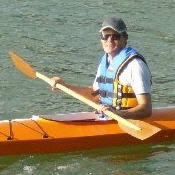Last night I tried to get out all the athwart ship parts from a sheet of 9mm ply. Rather than using a table of offsets, these parts are shown as a full scale half-profile on the plans.
Step 1 was to hold the plans up to a window and carefully draw on the back of the half profiles, including the centre line.
Step 2 was to draw a centre line on the ply and pin the plans on top, taking care to place the pins through the centre line on both the plan and the wood.
Step 3 was to use an awl to poke marks through the plan into the wood on all the corners plus plenty of points along the curves.
Step 4 was to unpin the plans and then carefully pin them back again using the same pin holes but with the plans turned over.
Step 5 was to repeat step 3 to produce the other half of the profile.
Step 6 was to carefully join the awl marks with a pencil line. Note that although I marked the positions of the stringer cutouts, I don't intend to cut these until I've sourced my softwood since it is unlikely to match the dimensions given on the plans.
Step 7 was to cut the parts out. I only cut out the two deck beams using a different jigsaw blade to the course one I used for the hull parts. The fine blade gave a much nicer cut, but light was fading and I was finding it difficult to follow the line, so I stopped before I wasted any wood.
Step 8 was to trim up the parts right up to the line. I only did this to one of the deck beams. The straight ends I decided to cut with a panel saw to get a good, straight edge. This would have been fine if the saw hadn't of slipped and scratched the surface of the part. This was when I knew i was rushing and was getting sloppy, so time to stop work.
Given that the one deck beam was likely to be scrap now, I experimented with trimming the outer curve. The Stanley Bailey block plane made very short work of this, I love that tool.
The inner edge presents more of a problem though. Some of the concave curves on the hull parts were just about manageable with the block plane, given their very gentle curve. But the deck beams have a quite tight radius to their undersides, and for this I need a spoke shave.
All the usual outlets have drawn a blank on this front, so I'm going to check out the second hand tool stores at the Takapuna market on Sunday, keep my eyes open on TradeMe and see if I can beg steal or borrow one from anyone I know. Failing that it'll be course sandpaper round a piece of thick dowel.
I'll add photos to this post later, to show the marking out process.
Step 1 was to hold the plans up to a window and carefully draw on the back of the half profiles, including the centre line.
Step 2 was to draw a centre line on the ply and pin the plans on top, taking care to place the pins through the centre line on both the plan and the wood.
Step 3 was to use an awl to poke marks through the plan into the wood on all the corners plus plenty of points along the curves.
Step 4 was to unpin the plans and then carefully pin them back again using the same pin holes but with the plans turned over.
Step 5 was to repeat step 3 to produce the other half of the profile.
Step 6 was to carefully join the awl marks with a pencil line. Note that although I marked the positions of the stringer cutouts, I don't intend to cut these until I've sourced my softwood since it is unlikely to match the dimensions given on the plans.
Step 7 was to cut the parts out. I only cut out the two deck beams using a different jigsaw blade to the course one I used for the hull parts. The fine blade gave a much nicer cut, but light was fading and I was finding it difficult to follow the line, so I stopped before I wasted any wood.
Step 8 was to trim up the parts right up to the line. I only did this to one of the deck beams. The straight ends I decided to cut with a panel saw to get a good, straight edge. This would have been fine if the saw hadn't of slipped and scratched the surface of the part. This was when I knew i was rushing and was getting sloppy, so time to stop work.
Given that the one deck beam was likely to be scrap now, I experimented with trimming the outer curve. The Stanley Bailey block plane made very short work of this, I love that tool.
The inner edge presents more of a problem though. Some of the concave curves on the hull parts were just about manageable with the block plane, given their very gentle curve. But the deck beams have a quite tight radius to their undersides, and for this I need a spoke shave.
All the usual outlets have drawn a blank on this front, so I'm going to check out the second hand tool stores at the Takapuna market on Sunday, keep my eyes open on TradeMe and see if I can beg steal or borrow one from anyone I know. Failing that it'll be course sandpaper round a piece of thick dowel.
I'll add photos to this post later, to show the marking out process.

Photo of the marking out process, as promised.

No comments:
Post a Comment